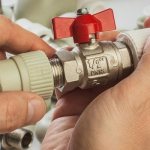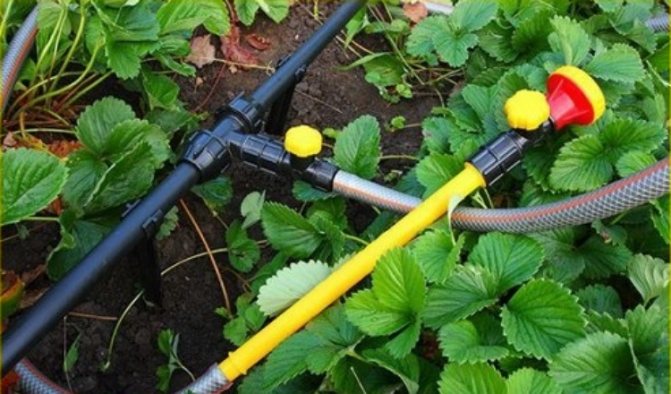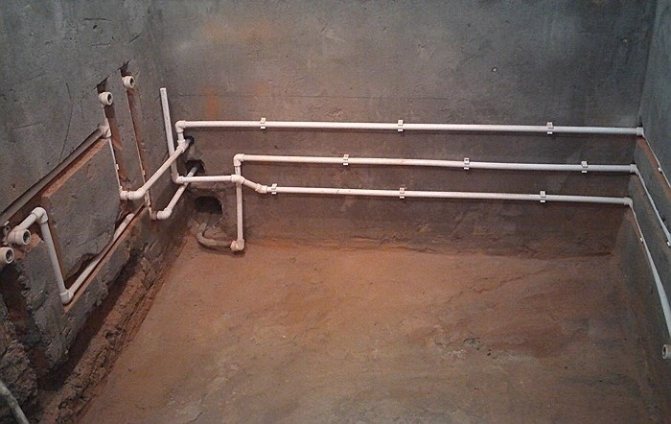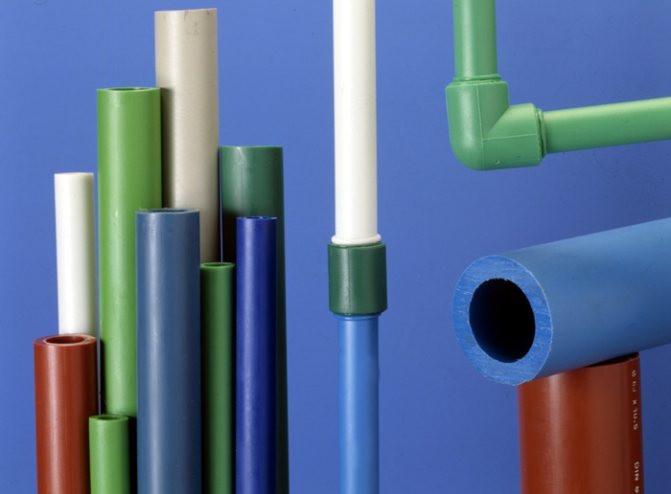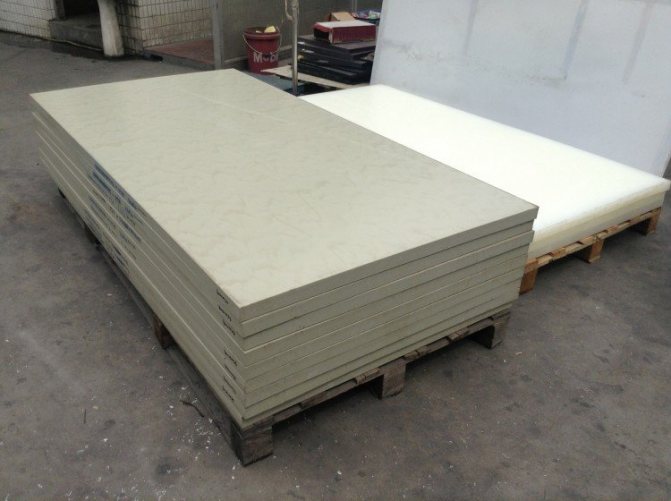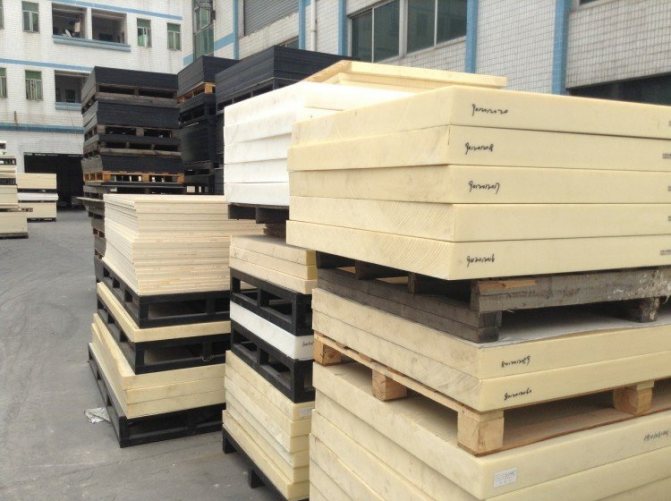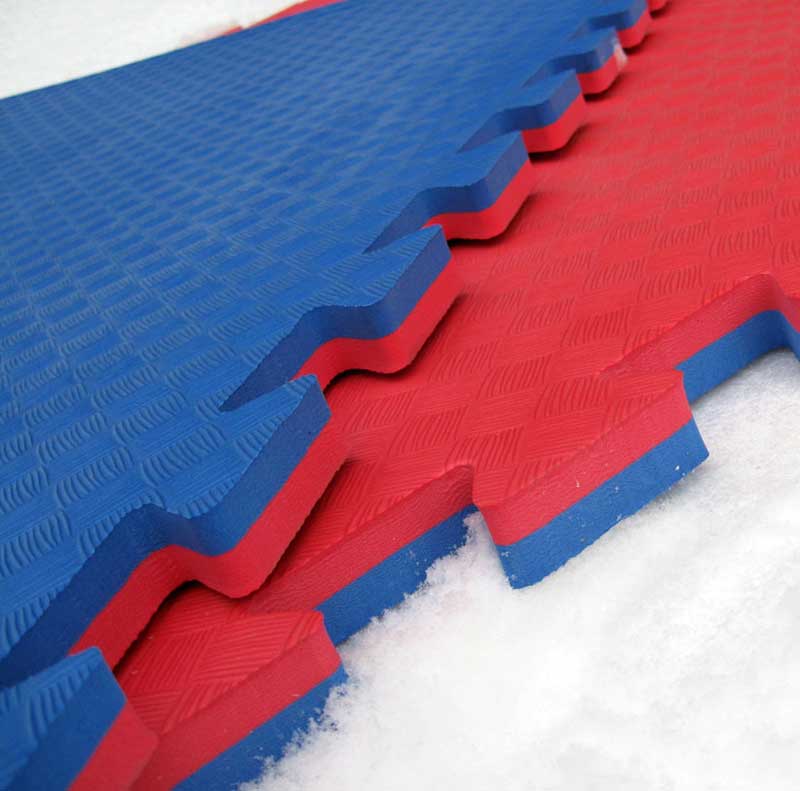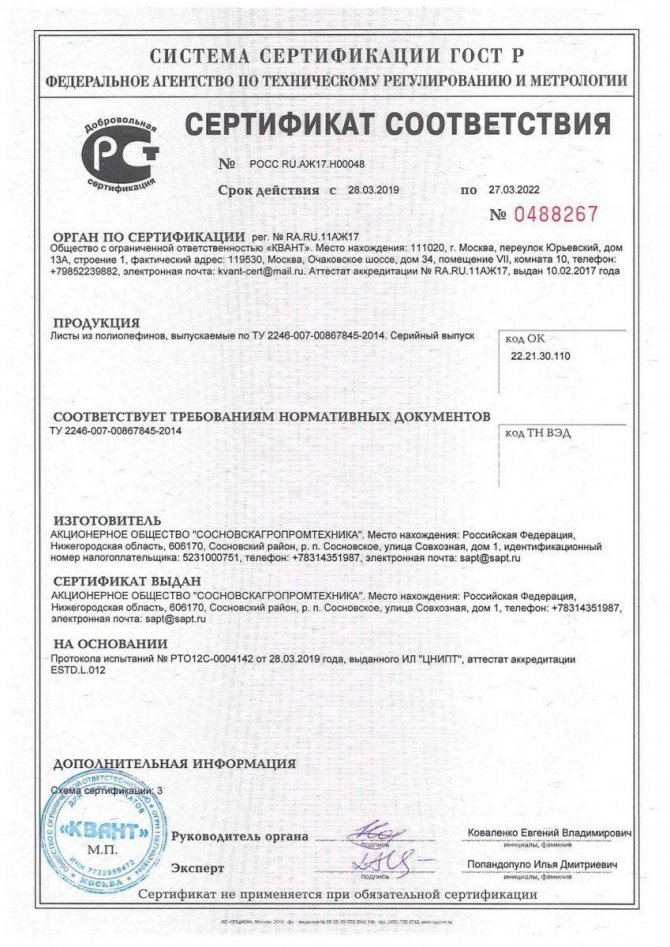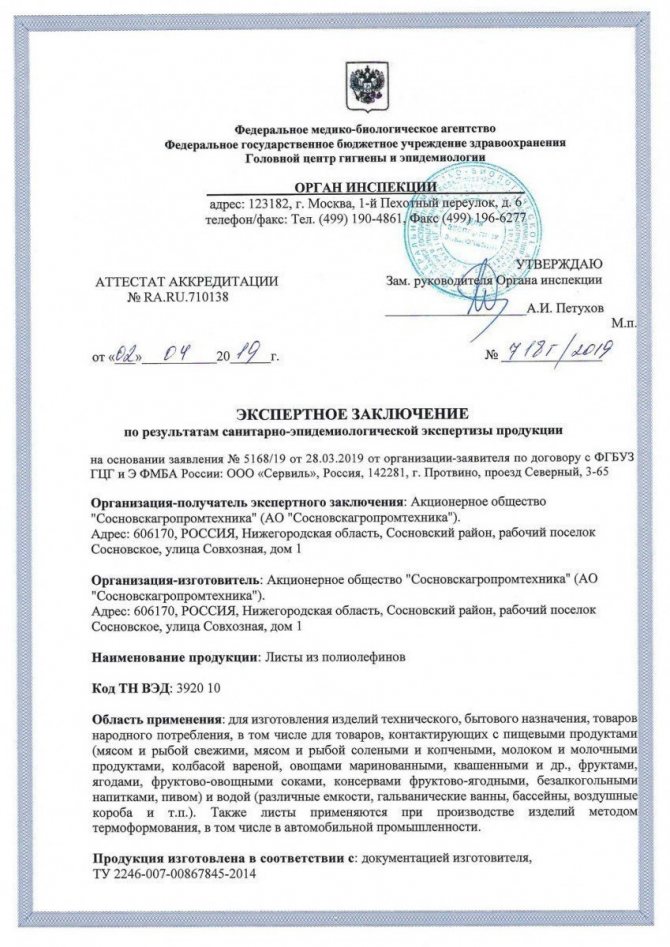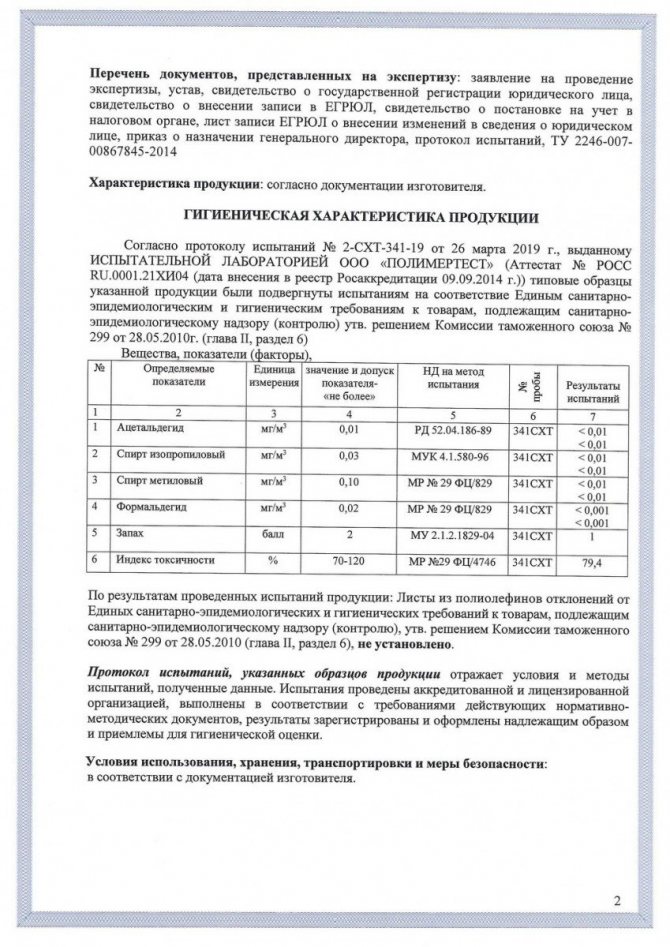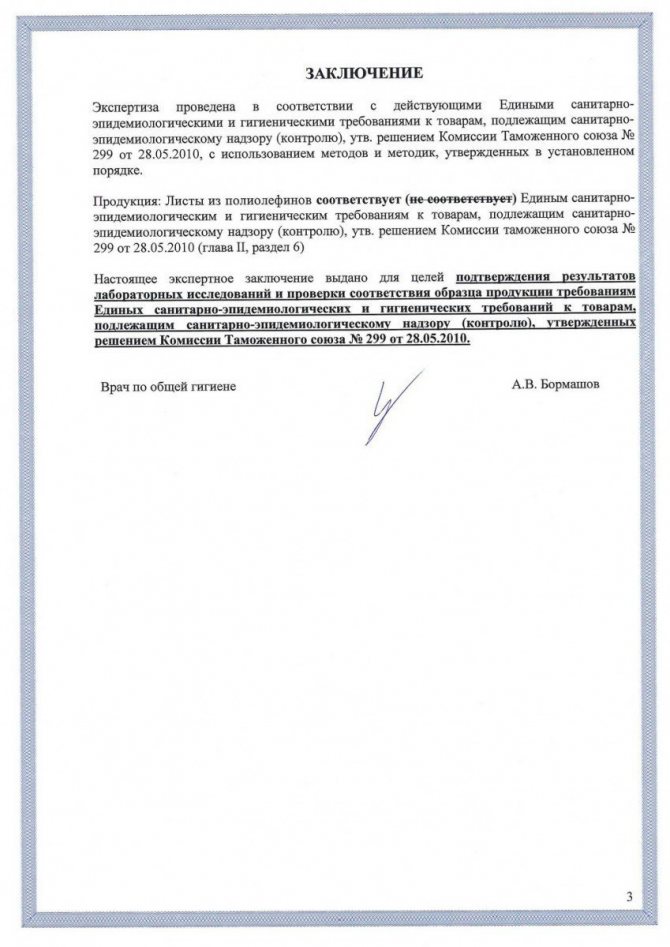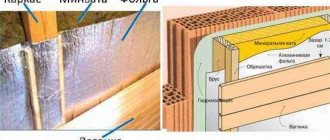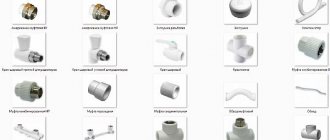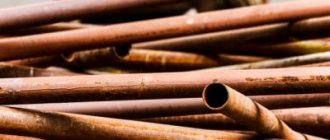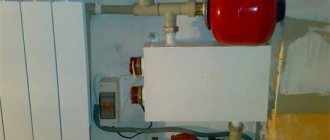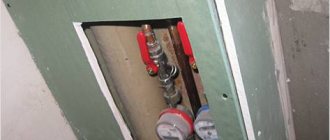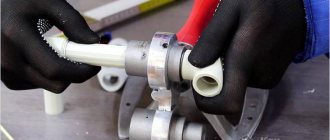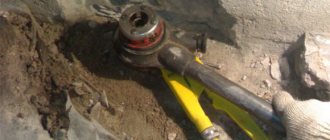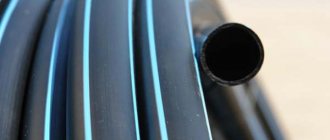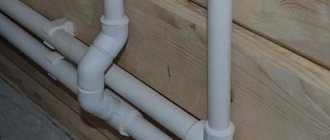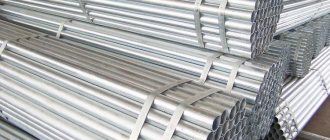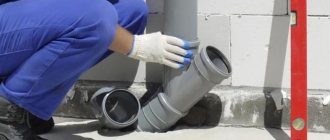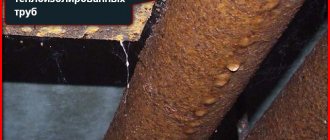Having made the decision to improve your home, you probably have already considered the question of how to lay a polypropylene water supply system with your own hands. Due to the low performance characteristics, metal pipes at the present stage of technology development are considered to be an atavism. At the same time, even a beginner can assemble a system using polypropylene products. The main thing is to carry out work strictly according to the technology, and then the water supply system will serve for about 50 years.
You can assemble a water supply system from polypropylene pipes both in a city apartment and in the country.
Benefits of PP communications
Before proceeding with the installation, it is necessary to prepare a project and purchase material. And here the question arises - which is better for a water supply system, metal-plastic or polypropylene? Experts have not come to a consensus, so it would be useful to know the arguments in favor of each option. Comparative characteristics of both types of pipe products are presented in the table below.
Table 1
| Parameter | Metal-plastic | Polypropylene |
| Cold water supply system. Service life, years | More than 50 | 50 |
| Hot water supply system. Service life, years | 50 | 25 |
| Maximum temperature | + 110˚С | + 95˚С |
| Working temperature | + 95˚С | + 75˚С |
| Working pressure, atmospheres | 10 | 10 |
As you can see, metal-plastic products are more preferable in terms of technical characteristics. However, it should be noted that for domestic use, the properties of polypropylene pipes are quite sufficient, therefore, you should not be afraid of their premature breakdown and damage.
At the same time, they have the following obvious advantages:
- low cost. Arrangement of a water supply system in an apartment with your own hands made of polypropylene will cost you 25-40 percent less than if metal-plastic pipes were used;
- it has already been said above that the installation of pipes made of this polymer requires significantly less labor costs. So if voluminous work is performed for the first time, then when choosing between polypropylene and metal-plastic, preference should be given to the first option.
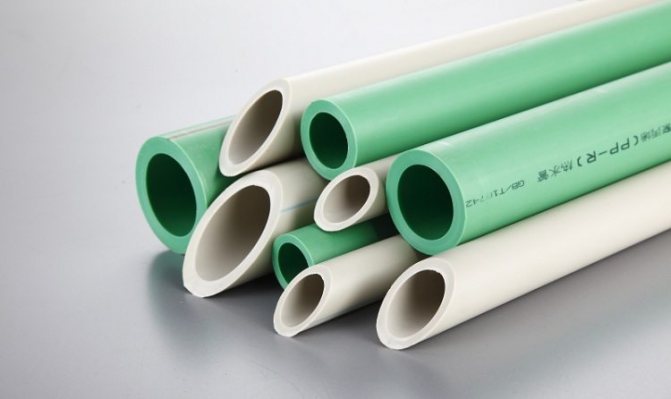
Polypropylene pipes in terms of technical characteristics are not inferior to other types of polymer products
Main features of polypropylene sheet
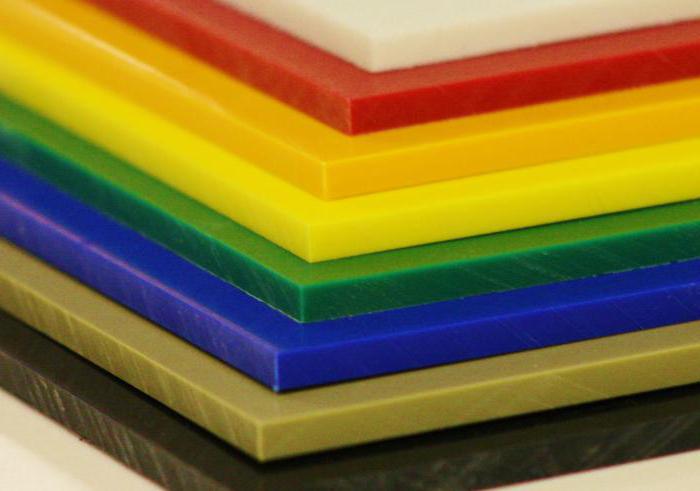

The described material is made according to a special technology, which involves forcing a molten composition having a viscous state. According to its properties, the material is resistant to aggressive media. It does not allow electrical current and moisture to pass through. It is contraindicated to use it for storing oxidants. It quickly adapts to weather conditions, which allows it to be used at minus and plus temperatures. Polypropylene sheet is UV resistant.
Water supply system design
Installation of a water supply system from polypropylene pipes in an apartment will not cause any complaints, provided that a wiring diagram has been correctly drawn up, containing the requirements for connections and fasteners of structural elements. This approach involves minimizing the length of the pipeline and the absence of unnecessary bends and unnecessary details in the project.
Advice! To get the most accurate idea of the final product, namely, to find out the number of bevels and bends, the intersection of pipes, outline the laying scheme directly on the walls with a pencil.
Polypropylene "hot" and "cold" water supply can be realized in two ways: open or closed. The second, despite the fact that it is more complicated, is used more often.Here you cannot do without accurate calculation and professional execution. Most of the piping must be made without joints. Welding does not reduce the reliability of the entire system, but it is still better to leave the joints open. So you can regularly inspect your water supply system and carry out preventive work with it without difficulties.
Open wiring is another matter entirely. The choice of this option also allows you to make the pipes less "noticeable". This is achieved by laying them along the floor level in horizontal planes, and in the corners of the premises, the pipes are already placed vertically.
Open wiring has the following advantages:
- ease of installation;
- ease of maintenance;
- the ability to quickly replace part of the system in the event of a leak.
It should be noted that the wiring of polypropylene pipes in the bathroom and in the kitchen can be carried out in both open and closed ways. This is another plus in favor of tubular products made from this polymer.
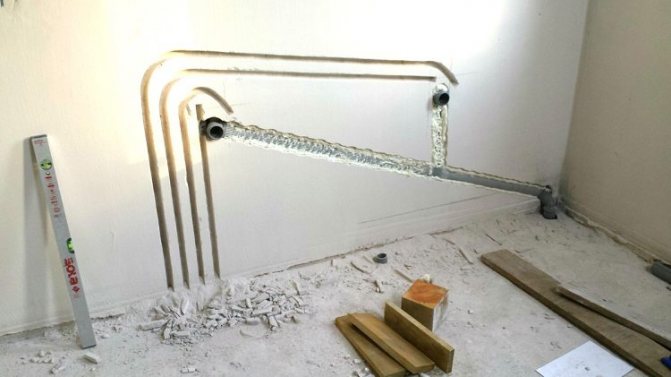

Laying the system in a closed way is more laborious: it is necessary to make grooves and carefully seal the pipe joints
Installation rules for polypropylene products
Initially, it will be necessary to cut the pipe elements to the desired length. For work, use a special tool. To switch from one diameter to another, special couplings must be used, while corners are needed for bypassing and turning. In order to go around the pipe, you need to use a bypass. Among other things, crosses, plugs and tees will be involved. All these models are available in various diameters, so you need to carefully study the water supply scheme before purchasing.
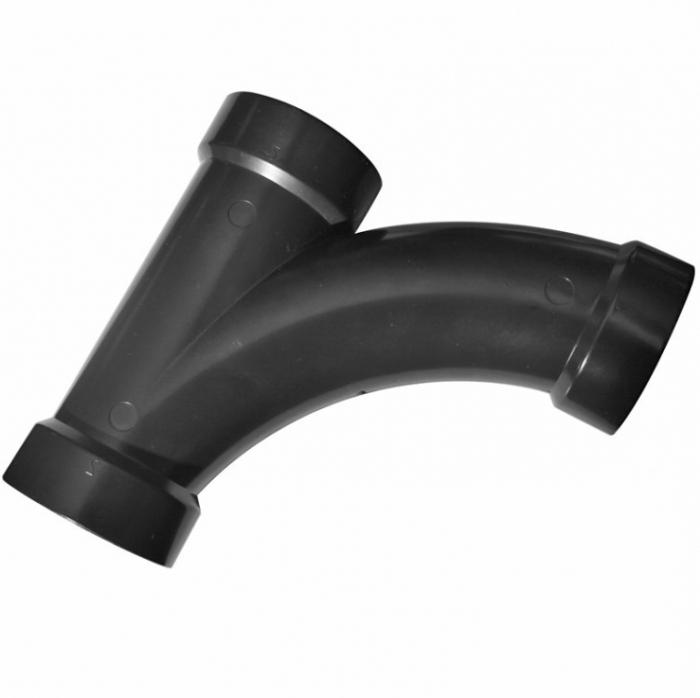

In order to secure the pipe to the wall, clips should be used. They need to be fixed in increments of 2 meters, which is true for straight segments. Among other things, they are located in the places of corner mates. If the pipes need to be stacked one on top of the other, then double clips should be used. When working with risers, it is recommended to use steel clamps that have rubber gaskets as fasteners. The element will bend around the pipe, forming a kind of ring. It must be tightened using a nut or bolt. Professionals advise to mount the turn of the inner corner of the hot pipe with a step of 3 meters from the wall surface.
Materials and tools. Getting Started
Having developed a diagram and making a drawing, you can go to a building materials store to buy the necessary tools.
- the first step is to purchase a soldering iron for working with plastic. Plumbers call it an iron. If you do not plan to constantly install water pipes, you can buy a cheap similar device, since you will not need an expensive soldering iron with a long warranty;
- polypropylene pipes will need to be cut. Special scissors are used for this. They are inexpensive. However, this operation is also allowed with a hacksaw for metal;
- corners, tees and other fittings that function as connecting elements are also purchased. They are made from the same polymer as the pipes themselves. But their diameter differs upwards, and it is recommended to purchase them with a small margin.;
- In addition, you will need a building level, a square, a measuring tape, an adjustable wrench, a marker and a rag. Don't forget about gloves too. They will prevent you from getting thermal burns while servicing the nozzles.
Before installing a new pipeline, you will need to dismantle the old one. To do this, close the main riser in the apartment. Then carefully remove the pipes. For convenience, they can be cut in suitable places. Unnecessary destruction must be avoided. Otherwise, you will be forced to deal with the restoration of the floor and walls.
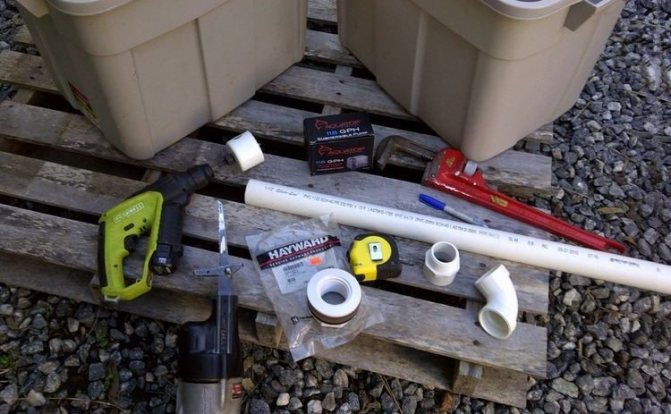

Before starting work, you should prepare the pipe, fittings for it and simple tools
If you need to replace all the water supply lines in the apartment, you will have to contact the housing office, because without blocking the riser in the entire entrance, this procedure will not work. Moreover, in order not to have trouble with neighbors, they should be warned about the impending lack of water.
Variety of ideas for a country house
Gardeners and gardeners can easily assemble irrigation systems from plastic pipes.
Vertical beds are popular, where they grow:
- Strawberry;
- salad;
- dill and parsley;
- cucumbers and beans.
Arranging and decorating the site, craftsmen use plastic sewer pipes to create original flower beds, flower beds or unusual flower pots and pots.
To connect numerous elements, you will need a plastic fitting, corners, tees. However, handmakers prefer to mount structures, fixing parts with an adhesive. There is another method of fastening. It is recognized as time consuming and not always beginners dare to use it. With such an installation, make markings after accurate measurements, drill a certain number of holes of different diameters.
The dacha is the place where many flowers are planted. They grow in flower beds, in pots and alpine slides, on supports. Curly arches made of PVC pipes will be an excellent support for climbing plants. Install such an arch in front of the gazebo, near the pool, at the entrance to the house. Take care only of fixing the structure. For this, it is not enough to assemble a structure exclusively from plastic pipes. You will need metal rods or reinforcing rods bent into the desired shape. Tubes are put on them, and the ends are deepened into the soil, achieving the stability of the structure.
The decoration of any suburban area is a garden. Plants planted here require careful maintenance and proper watering. The water supply system can also be assembled from plastic pipes.
An early harvest of vegetables is the pride of any summer resident. To be the first to grow tomatoes, cucumbers, greens, you need a reliable greenhouse or a small greenhouse. Ready-made structures are expensive, and with the help of scraps of plastic pipes, a structure is erected, which it is enough to cover with a special film to get a spacious greenhouse or a convenient greenhouse that does not take up much space on the site.
Fences, fences for flower beds, stair railings, garden furniture (armchairs, tables, chairs, benches), sun loungers, awnings for gazebos - all these are structures, the best material for which is plastic pipes. They do not require much maintenance. If the installation was carried out without using an adhesive, then seasonal products can be easily disassembled and stored in a garage or other technical room. A personal car will not suffer from exposure to the sun or rainwater if, upon arrival at the dacha, you leave it under a canopy made of PVC pipes.
Installation features
First, pipes are selected for the assembly of water supply circuits of both types - hot and cold.
On a note! To make the right choice, you need to know the labeling of such products. For most manufacturers, it is universal.
- on polypropylene pipes for cold water there is the following sequence of symbols: PN10;
- for the organization of cold and hot water supply, universal pipe products are used, marked as follows: PN16. They do not cost much more, therefore, in this case, only such pipes should be purchased;
- if an autonomous boiler room is installed in the house, and you use very hot water, purchase PN20 products with internal high-quality reinforcement.
The following restrictions are imposed on the diameters of polypropylene water pipes:
- a compact pipeline with a loop length of less than 10 meters, can be created from pipes with a diameter of 20 millimeters;
- when the total length of the contours does not exceed 30 meters, the minimum diameter should be 25 millimeters;
- contours longer than 30 meters are created from polypropylene pipe products with a diameter of 32 millimeters. The same cross-section should have the risers for supplying cold and hot water.
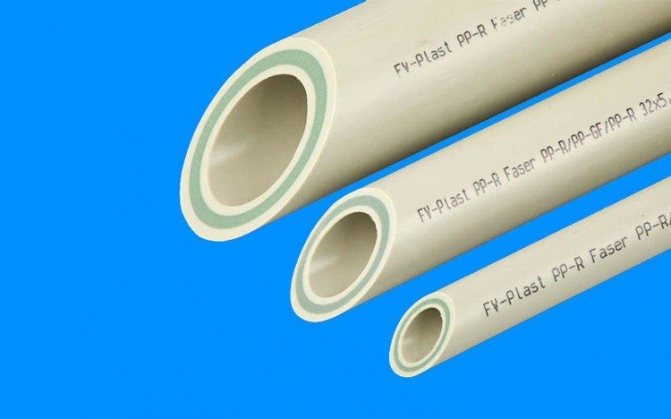

The diameter of the pipes is selected depending on the type of water supply and its length - the longer the circuit, the thicker the pipe should be
The wiring of polypropylene pipes itself can be carried out in two ways:
- parallel - assumes the presence of a collector with several outputs. Each of them is connected to a separate circuit for a specific consumer. This option provides the ability to evenly distribute the pressure inside the water supply system. At the same time, the implementation of such a scheme will require more financial costs. However, despite this, experts recommend making a choice in favor of this particular option;
- sequential - a horizontal branch is laid from the riser or main line, followed by cutting tees into it. From these fittings, pipes are supplied to consumers. The cost of such a design is significantly lower than the previous one, but if several taps are turned on at the same time, the head will noticeably decrease.
Collector device
Both a factory-made metal and a home-made polypropylene manifold includes two parts:
- The first element ensures the connection of the flow line leaving the boiler with the flow pipes of the heating circuits, i.e. this part of the collector distributes the heated coolant. This collector element is also important in the ability to make the circuits independent, which simplifies their maintenance and repair. If there is a collector to repair one of the circuits, it is enough to close the valve corresponding to it, which will stop the supply of the coolant to this pipeline.
- In the second part of the collector, the pressure in each circuit is regulated, due to which the intensity of the coolant circulation is determined. The efficiency of all heating systems directly depends on the correct setting of the movement of hot water in the mains.
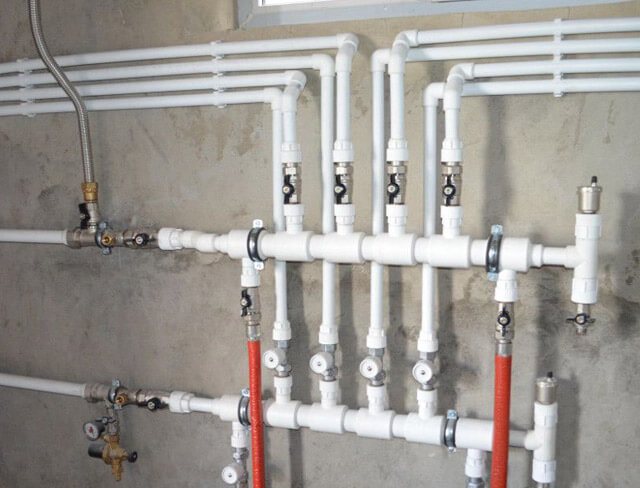

Inexperienced craftsmen very often integrate a set of additional elements into the system, believing that these devices will be able to optimize the heating operation. In most cases, such a solution turns out to be useless, because a lack of understanding of the reason for the decrease in heating efficiency does not make it possible to competently intervene in the heating operation. A self-assembled polypropylene collector is often the most necessary, optimal solution to the problem of reduced heat transfer from heating.
Formation of pipe connections
This procedure has no difficulties. However, ignorance of how to make a do-it-yourself plumbing from polypropylene will not allow you to create a reliable structure. Installation involves the following actions:
- First, the section of the pipeline to be laid is cut off. To do this, you can use a regular plastic saw, but it is better to perform this operation using a special pipe cutter.
- To get a stronger connection, it is necessary to clean the pipe (its edges) from burrs.
- Then fittings are selected. All elbows, elbows, couplings, adapters should be purchased in advance.
- Then a soldering iron for pipes is taken, a pair of nozzles with a section corresponding to the diameter of the fitting and pipes that will be put on these nozzles are inserted into it.
- Next, the parts to be joined are put on the above nozzles, and after that the soldering iron is turned on. The degree and time of heating are quantities derived from the power of the device and the pipe walls.
- After the heating is completed, the parts are removed from the nozzles, and the pipe is pushed into the fitting without rotation.
- The compound is kept for 30 ... 40 seconds, after which it must be allowed to cool down. The process of complete polymerization of polypropylene lasts no more than an hour, so soon it will be possible to check the correctness of the installation of the water supply system from polypropylene pipes, primarily for the tightness of the connections.
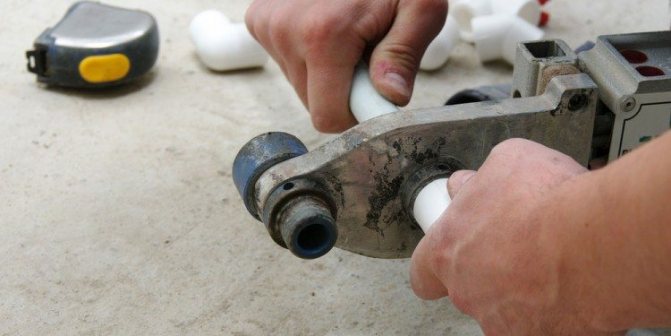

Installation of polypropylene pipes is carried out by welding, for this you need to have a special apparatus
Advice! To eliminate errors, you need to be guided by the table that comes with the soldering iron.
Pipe connections without welding
Let's take a closer look at how you can connect plastic pipes without soldering. Such methods do not require the use of additional equipment and, if you do not have the skills and ability to perform welding work on plastic, they seem to be the most simple.
In this case, the main connecting link is the fitting. A fitting is a connecting element of two or more pipes, which is installed for branching, turning, changing to a diameter of a different size, or with the help of it pipes are fastened, which are often dismantled later. [rek_custom1]
Features of a polypropylene water supply system in the country
The problem of water supply to the dacha worries many owners of suburban real estate - lovers of gardening activities. After all, then it will be very difficult to organize a full-fledged watering of the personal plot, without which you will only have to dream of a harvest. And the implementation of an alternative option - to carry water from a well or a nearby pond, will require excessive physical costs. The most effective and realistic way out is to equip a summer water supply system in a country cottage from polypropylene pipes.
But before that, you need to decide on its location. The conduit can be of two types:
Permanent water supply. It is laid underground and, as the name implies, does not provide for dismantling, at least until it fails. Subject to certain rules, it will be possible to use it not only in summer, but also in winter. We are talking about the implementation of methods that prevent water from freezing in the pipeline in severe frost. One of them is laying a water conduit at a depth below the freezing mark. If this is not possible, the pipes will have to be insulated. However, since the question of how to install a summer water supply system from polypropylene pipes in a summer cottage is now being considered, it will be useful to know some of the features of a permanent option.
The system is laid between trees in places of lawns at a depth of 25-30 cm. Areas passing under the beds, in order to prevent their damage during digging, should be deepened by 40-45 centimeters or even more. To prevent the pipes from breaking during the winter cold, in the fall, when the irrigation season is over, the water must be drained from the system. If the slope has not been created, this can be done by blowing out with a compressor.
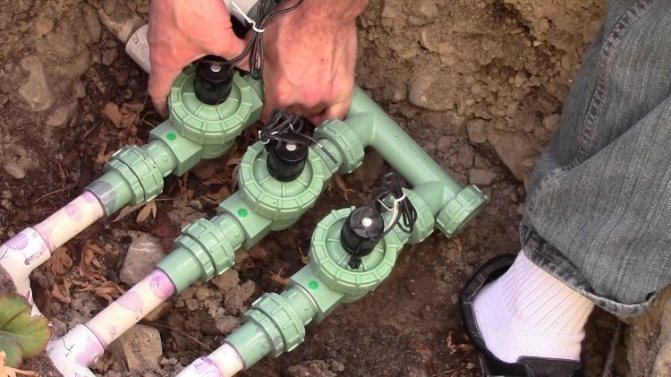

The plumbing system, which will be used all year round, must be laid underground, in specially dug trenches
Collapsible system. A water conduit of this type is laid on the soil surface. The advantages of this option include:
- quick installation and ease of connection to various water sources;
- all leaks that occur are immediately noticeable;
- requires a minimum of maintenance.
However, before the onset of cold weather, such a structure is recommended to be disassembled and removed from the site. Otherwise, in winter, its elements can simply be stolen.
Good to know! To create a summer water supply system, experts recommend using polypropylene pipes of the PN10 or PN16 brands.
Extra features
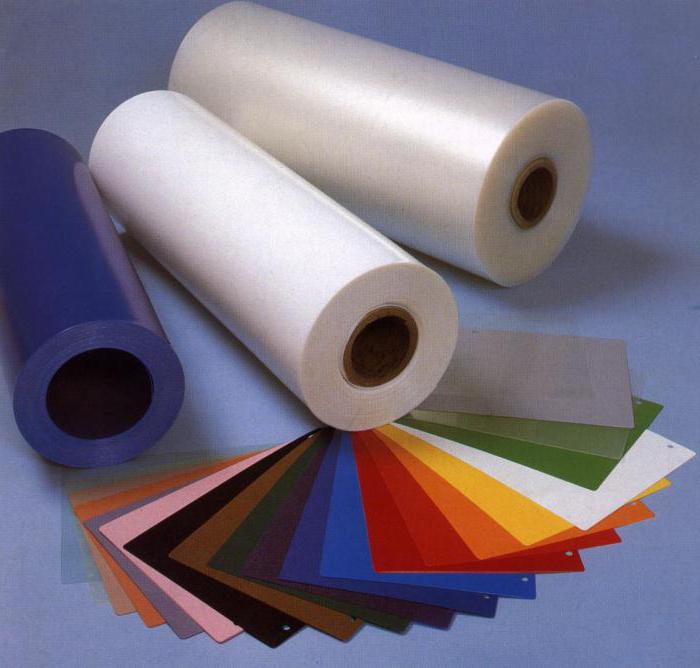

Polypropylene sheets have a low density and excellent resistance to high temperature. The PP-R variety is characterized by the ability to withstand temperatures from 0 to 100 ° C.If we are talking about polypropylene with the PP-C marking, then before you is a material that can be operated at a wider temperature range, which varies from -20 to +180 ° C.
It is characterized by high corrosion and chemical resistance, high tensile strength, water resistance and physical harmlessness. The material lends itself well to weldability and can be processed in any way. It is characterized by low impact strength and low frictional resistance. As one of the disadvantages, it is possible to single out the fact that sheet polypropylene is rather difficult to glue.
Sequence of installation steps
Installation of a summer water supply system involves the following activities:
- drawing up a detailed network diagram with mandatory binding to the site plan. On it, not only the equipment (sprinkler heads, taps, etc.) should be marked, but also all, without exception, the details of the pipeline - plugs, tees, corners, etc. The main wiring is usually done using a pipe with a diameter of 40 millimeters. Polypropylene pipe products with a diameter of 25 or 32 millimeters are used for taps to the water intake points. The diagram should indicate the depth of the trenches. The value of this parameter is on average 30-40, and under the beds 50-70 centimeters. It is also necessary to consider the method of drainage of the system. Usually, pipes are laid with a slope to the water source, and if such is the central water supply, then in the direction of the tie-in into it. There must be a drain valve at the bottom. The location and number of water taps are calculated taking into account that short sections of hoses, the length of which does not exceed 5 meters, could be used to irrigate the entire backyard plot. If the system is installed on a standard area of 6 acres, there can be up to 10 water intake points;
- after the development of the summer water supply scheme, a specification is drawn up. The purchase of equipment and materials is made on its basis;
- if the country water supply is supposed to be connected to a centralized network, then it will be necessary to make a tie-in. The simplest method, which, moreover, does not require turning off the water, is performed using a special part - a saddle. It is a clamp with a threaded branch pipe and a seal. First, this part is installed on the pipe. Then a ball valve is screwed onto its branch pipe, and then a hole is made right through it in the pipe wall. After that, the tap closes immediately;
- the next stage is the preparation of trenches for pipe laying;
- then the system is assembled. That is, pipelines are connected to taps and other components through fittings;
- upon completion of the assembly, the finished water supply system is tested for tightness. For this, water is supplied to it and the state of the compounds is observed for some time;
- if leaks do not appear, trenches with water supply are buried.
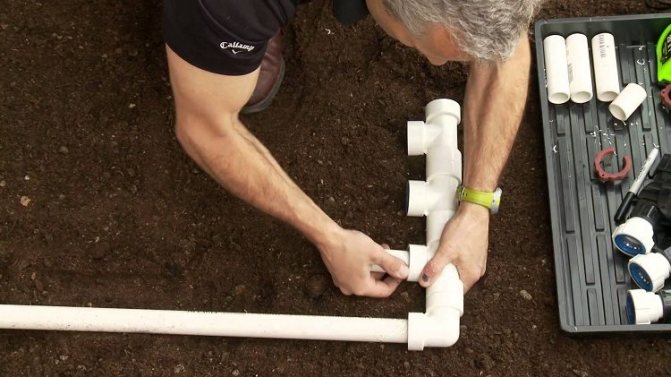

To connect pipes, fittings of the same material as the pipes are used, they can be welded or glued
Application of expanded polypropylene
The properties possessed by expanded polypropylene make this material in demand in various fields of activity... The main areas of its application are:
- external wall insulation of existing residential and office buildings;
- the material can be used as a heater for sandwich panels and in-wall cassettes of enclosing structures of industrial buildings and structures;
- used as a sound-absorbing filler for interior walls and partitions;
- due to the high degree of hydrophobicity, the material is successfully used as hydro and thermal insulation in rooms with a high degree of humidity and a sharp change in temperature: in baths, saunas, steam rooms, showers;
- it is used as a vibration-insulating layer for floor construction, including in underfloor heating structures;
- used for noise insulation of cars;
- composites based on expanded polypropylene are used to fill filters in water treatment plants;
- various types of packaging containers are made from expanded polypropylene;
- foil-clad polypropylene is used for the production of thermos containers and boxes for the transportation of medicines in ampoules, flasks, test tubes;
- EPP is used as a cushioning pad for bicycle and motorcycle helmets.


Porous polypropylene of both domestic and foreign production is presented on the materials market. The products of domestic manufacturers are distinguished by a lower cost and a sufficiently high quality. At the same time, more expensive foreign materials have a very wide range of colors, thicknesses and sheet sizes.
You can get acquainted with another synthetic polymer - ABS plastic - in this article.
Devices and devices
To make summer cottage water supply systems more practical, the following devices are used:
- fitting. With it, the connection of the hose to the tap is very quick. On the one hand, it has a "ruff", which is simply inserted into the tap, and on the other, a spring grip;
- corrugated hoses. When folded, very little storage space is required;
- special accessories for the organization of drip irrigation;
- watering guns and sprayers equipped with special couplings of the aquastop type.
- hoses, as well as special accessories for the organization of drip irrigation;
- watering and sprinkling heads;
- soil moisture sensors or timers. With their use, watering is carried out in automatic mode.
Good to know! When the sprinkler is replaced, these fixtures automatically shut off the water (without having to close the tap).
And in conclusion, one important piece of advice. Professionals recommend installing the line in the direction from consumers to the points of water intake.
For children
The arrangement of a children's bedroom in a country house requires the installation of furniture. Here the child will rest after a day full of work, games, events. It makes no sense to install expensive furniture brought from the city in such a room.
With the help of fasteners from pipes are assembled:
- computer table;
- racks for storing toys;
- chairs;
- bed.
Having carefully studied the design features, the master will independently assemble a bunk bed.
Sunny, warm days are the time when the child does not sit in the house. He is constantly in the yard, where a plot was previously allocated for the construction of a playground.
This is done from plastic pipes of different diameters and lengths. Having prepared the required number of connecting elements, plugs, fittings and the necessary tools, the handmaker is able to make a screen for theatrical performance, behind which young artists, chairs for young spectators, tables for treats and even lamps will be hidden.
The use of plastic pipes can also be found in those families where there is a small child who needs a crib like a playpen for a quiet and safe sleep.
Polypropylene under the microscope
The technical characteristics of polypropylene pipes are largely determined by the properties of the plastic itself.
Several types of polymers can be distinguished:
- homopolymer (brittle at low temperatures);
- block copolymer - characterized by high elasticity, but wears out quickly.
But the random copolymer (also called type 3 polymer) is especially valuable. At low temperatures, it does not crumble, and the upper limit of the operating temperature is around 90 - 95ᵒ.
Such outstanding properties are achieved due to the introduction of ethylene into the PP molecular chain. It is this “neighbor” that gives the plastic such unusual properties.It is important that the price of the material practically does not change upwards.
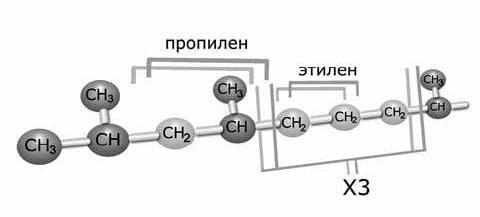

Molecular structure of type 3 polymer
It can also be noted that PP of the 3rd type is absolutely harmless to the environment, which is especially important during its processing. It is produced in the form of colorless granules.
Pipeline selection
When the work on replacing the water supply or heating in the house is done by hand, the question of choosing the right pipe is quite relevant. In this case, one must proceed from the operating conditions of the system.
Cold water supply
The standard pressure in the cold water supply system should be in the range of 0.3 - 6.0 atm, so PN10 pipes can be safely used for water supply (the number 10 indicates the maximum pressure that the pipeline can withstand without deformation).
For wiring around the apartment, a 25 mm polypropylene pipe is quite suitable. Of course, no one will prohibit the use of a reinforced pipeline for cold water, but this will simply lead to unnecessary costs, and will not affect the durability of the system in any way.


Pipe reinforcement scheme
Hot water supply
In the system for supplying consumers with hot water, the maximum pressure value is slightly less, it should not go beyond 4.5 MPa. As for the selection of the pipeline, here you also need to take into account the effect of temperature.
Note! The pressure that the pipe can withstand is indicated for room temperature (20 ᵒС), when heated to 80 - 90 С this value decreases by about 3 times.
As in the case of cold water supply, the diameter of pipes distributing hot water around an apartment does not usually exceed 25-32 mm. But for risers, a 50 mm polypropylene pipe may well be used. The selection can be performed according to the data in the table.
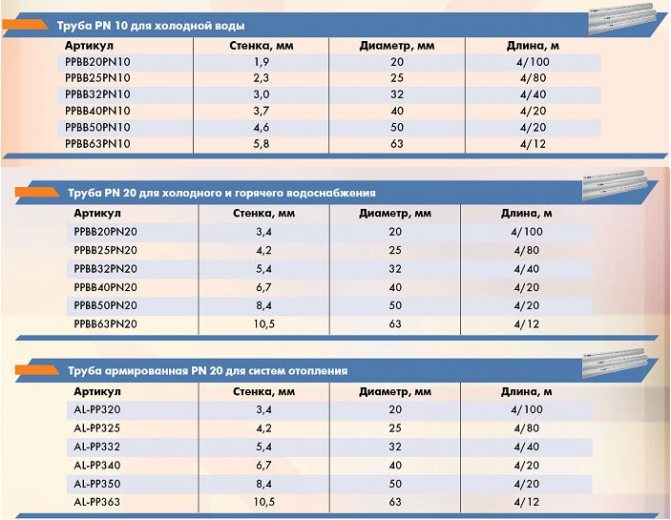

Data for the selection of the pipeline
For hot water supply, PN20 pipelines are most often used. You can also meet a less common pipe - PN16, but for it the maximum temperature of the coolant is limited to 60 ᵒС.
Heating system
The temperature of the coolant can reach 95 ° C, which, in combination with the pressure in the system, puts forward increased demands on the pipeline. The installation instructions for heating systems only allow the use of reinforced PP pipes (PN20 or PN25). A polypropylene pipe PN 25 to 20 with PPR-FB-PPR marking indicates that the reinforcement was carried out using fiberglass - this is the main difference between PN25 and PN20.
In the case of autonomous heating in the area directly adjacent to the boiler, the temperature of the coolant can also exceed 100ᵒС, so the PP is not suitable here. To solve this problem, there is usually a small section of steel piping from the boiler, and the rest of the wiring is done using polypropylene. The temperature of the heating medium is also influenced by the average outside temperature.
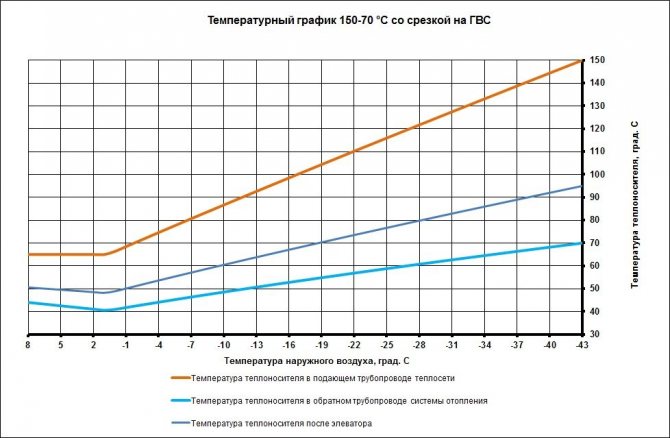

The relationship between the temperature of the coolant and the temperature outside the window
As for the diameters, the following standard sizes are most often used:
- for wiring on floors - no more than 32 mm;
- for the risers of the heating system, a 63 mm polypropylene pipe may well be used.
Corrugated PP pipeline
Corrugated pipes can be used for sewer systems or as cable ducts (naturally, such pipes are produced with a much smaller diameter). The sewerage system operates in a free-flow mode, and the cable channel does not experience serious loads at all, therefore, the requirements for such a pipeline are not so high.
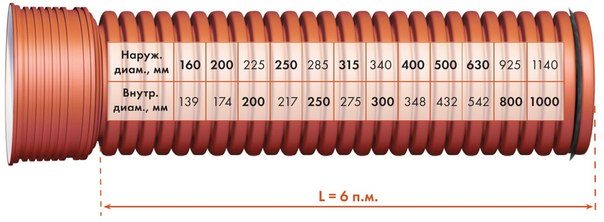

Sizes of PP pipes for external sewerage
The corrugated polypropylene pipe for sewage is produced in two layers. Outside, the surface is wavy, which increases rigidity and allows you to more effectively transfer soil pressure, and inside it is smooth, which practically does not interfere with the movement of the water flow.
As for the cable ducts, such tubes are produced in single-layer, for them polypropylene of increased elasticity is used. In this case, fire safety is considered the main characteristic, the PP should not burn and emit harmful substances into the atmosphere.
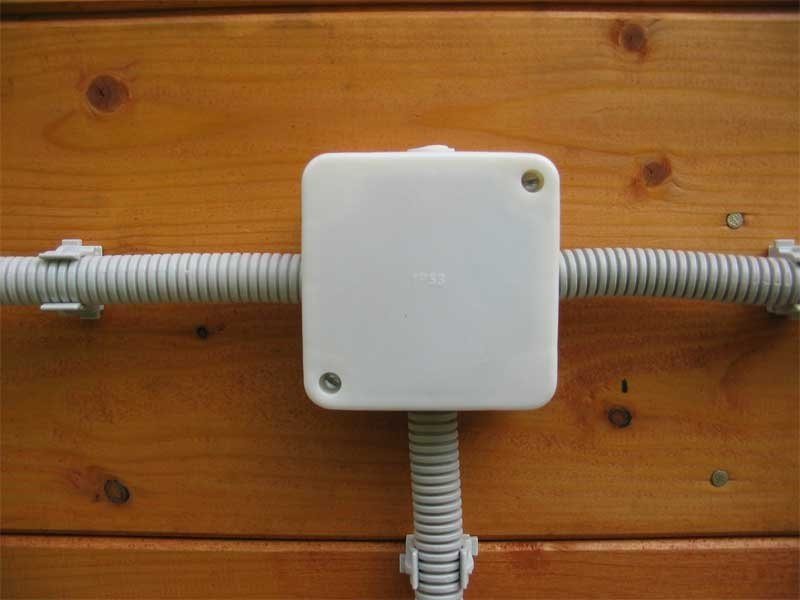

In the photo - the use of the pipeline as a cable channel

